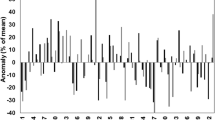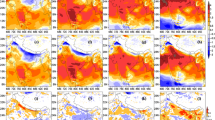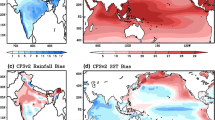Abstract
A global forecast system model at a horizontal resolution of T1534 (\({\sim }12.5\, \hbox {km}\)) has been evaluated for the monsoon seasons of 2016 and 2017 over the Indian region. It is for the first time that such a high-resolution global model is being run operationally for monsoon weather forecast. A detailed validation of the model therefore is essential. The validation of mean monsoon rainfall for the season and individual months indicates a tendency for wet bias over the land region in all the forecast lead time. The probability distribution of forecast rainfall shows an overestimation (underestimation) of rainfall for the lighter (heavy) categories. However, the probability distribution functions of moderate rainfall categories are found to be reasonable. The model shows fidelity in capturing the extremely heavy rainfall categories with shorter lead times. The model reasonably predicts the large-scale parameters associated with the Indian summer monsoon, particularly, the vertical profile of the moisture. The diurnal rainfall variability forecasts in all lead times show certain biases over different land and oceanic regions and, particularly, over the north–west Indian region. Although the model has a reasonable fidelity in capturing the spatio-temporal variability of the monsoon rain, further development is needed to enhance the skill of forecast of a higher rain rate with a longer lead time.
















Similar content being viewed by others

References
Abhik S, Krishna R P M, Mahakur M, Ganai M, Mukhopadhyay P and Dudhia J 2017 Revised cloud processes to improve the mean and intraseasonal variability of Indian summer monsoon in climate forecast system: Part 1; J. Adv. Model. Earth Syst. 9(2) 1002–1029.
Abhik S, Mukhopadhyay P, Krishna R P M, Salunke K D, Dhakate A R and Rao S A 2016 Diagnosis of boreal summer intraseasonal oscillation in high resolution NCEP climate forecast system; Clim. Dyn. 46(9–10) 3287–3303.
Borah N, Sahai A K, Abhilash S, Chattopadhyay R, Joseph S, Sharmila S and Kumar A 2015 An assessment of real-time extended range forecast of 2013 Indian summer monsoon; Int. J. Climatol. 35 2860–2876.
Chakraborty A 2010 The skill of ECMWF medium range forecasts during the year of tropical convection 2008; Mon. Weather Rev. 138 3787–3805.
Dandi A R, Sabeerali C T, Chattopadhyay R, Rao D N, George G, Dhakate A, Salunke K, Srivastava A and Rao A S 2016 Indian summer monsoon rainfall simulation and prediction skill in the CFSv2 coupled model: Impact of atmospheric horizontal resolution; J. Geophys. Res. Atmos. 121(5) 2205–2221.
Dee D P, Uppala S M, Simmons A J, Berrisford P, Poli P, Kobayashi S, Andrae U, Balmaseda M A, Balsamo G, Bauer P, Bechtold P, Beljaars A C M, van de Berg L, Bidlot J, Bormann N, Delsol C, Dragani R, Fuentes M, Geer A J, Haimberger L, Healy S B, Hersbach H, Hólm E V, Isaksen L, Kållberg P, Köhler M, Matricardi M, McNally A P, Monge-Sanz B M, Morcrette J-J, Park B-K, Peubey C, de Rosnay P, Tavolato C, Thépaut J-N and Vitart F 2011 The ERA-interim reanalysis: Configuration and performance of the data assimilation system; Quart. J. Roy. Meteorol. Soc. 137 553–597, https://doi.org/10.1002/qj.828.
Finley J P 1884 Tornado predictions; Am. Meteorol. J. 1 85–88.
Gadgil S and Gadgil S 2006 The Indian monsoon, GDP and agriculture; Econ. Polit. Wkly 41 4887–4895.
Ganai M, Krishna R P M, Mukhopadhyay P and Mahakur M 2016 The impact of revised simplified Arakawa–Schubert scheme on the simulation of mean and diurnal variability associated with active and break phases of Indian summer monsoon using CFSv2; J. Geophys. Res. Atmos. 121(16) 9301–9323.
Goswami B N, Venugopal V, Sengupta D, Madhusoodanan M S and Xavier P K 2006 Increasing trend of extreme rain events over India in a warming environment; Science 314(5804) 1442–1445.
Goswami B B, Deshpande M, Mukhopadhyay P, Saha S K, Rao S A, Murtugudde R and Goswami B N 2014 Simulation of monsoon intraseasonal variability in NCEP CFSv2 and its role on systematic bias; Clim. Dyn. 43 2725–2745, https://doi.org/10.1007/s00382-014-2089-5.
Hack J J, Caron J M, Danabasoglu G, Oleson K W, Bitz C and Truesdale J 2006 CCSM–CAM3 climate simulation sensitivity to changes in horizontal resolution; J. Clim. 19 2267–2289.
Huffman G, Bolvin D, Braithwaite D, Hsu K, Joyce R and Xie P 2014 Integrated multi-satellite retrievals for GPM (IMERG), version 4.4; NASA’s Precipitation Processing Center. Accessed 31 March 2015, https://arthurhou.pps.eosdis.nasa.gov/gpmdata/.
Joseph S, Mandal R, Sahai A K, Phani R, Dey A and Chattopadhyay R 2018 Diagnostics and real-time extended range prediction of heat waves over India; IITM Research Report (ISSN 0252-1075), ESSO/ IITM/SERP/ SR/03(2018)/192.
Kim I W, Oh J, Woo S and Kripalani R H 2018 Evaluation of precipitation extremes over the Asian domain: Observation and modelling studies; Clim. Dyn. https://doi.org/10.1007/s00382-018-4193-4.
Mahakur M, Prabhu A, Sharma A K, Rao V R, Senroy S, Singh R and Goswami B N 2013 High-resolution outgoing longwave radiation dataset from Kalpana-1 satellite during 2004–2012; Curr. Sci. 105 1124–1133.
Manganello J V, Hodge K I and Kinter J L et al. 2012 Tropical cyclone climatology in a 10-km global atmospheric GCM: Toward weather-resolving climate modeling; J. Clim. 25 3867–3893.
Miura H, Suematsu T and Nasuno T 2015 An ensemble hindcast of the Madden–Julian oscillation during the CINDY2011/DYNAMO field campaign and influence of seasonal variation of sea surface temperature; J. Meteorol. Soc. Jpn. 93A 115–137.
Nandargi S S and Gaur A 2015 Extreme rainfall events over the Uttarakhand State (1901–2013); Int. J. Sci. Res. 4(4) 700–703.
Prasad V S, Mohandas S, Das Gupta M, Rajagopal E N and Datta S K 2011 Implementation of upgraded global forecasting systems (T382L64 and T574L64) at NCMRWF; NCMRWF Technical Report No. NCMR/TR/5/2011 May 2011, 72p, http://www.ncmrwf.gov.in/ncmrwf/gfs.report.final.pdf.
Prasad V S, Mohandas S, Dutta S K, Das Gupta M, Iyengar G R, Rajagopal E N and Basu S 2014 Improvements in medium range weather forecasting system of India; J. Earth Syst. Sci. 123(2) 247–258.
Prasad V S, Johny C J and Sodhi J S 2016 Impact of 3D Var GSI-ENKF hybrid data assimilation system; J. Earth Syst. Sci. 125(8) 1509–1521.
Prasad V S, Johny C J, Mali P, Singh S K and Rajagopal E N 2017 Retrospective analysis of NGFS for the years 2000–2011; Curr. Sci. 112(2) 370–377.
Rajeevan M, Bhate J and Jaswal A K 2008 Analysis of variability and trends of extreme rainfall events over India using 104 years of gridded daily rainfall data; Geophys. Res. Lett. 35(18).
Rajendran K and Kitoh A 2008 Indian summer monsoon in future climate projection by a super high-resolution global model; Curr. Sci. 95(11) 1560–1569.
Roebber P J 2009 Visualizing multiple measures of forecast quality; Wea. Forecasting 24(2) 601–608.
Roxy M K, Ghosh S, Pathak A, Athulya R, Mujumdar M, Murtugudde R, Terray P and Rajeevan M 2017 A threefold rise in widespread extreme rain events over central India; Nat. Commun. 8(1) 708.
Sato M, Tomita H, Miura H, Iga S and Nasuno T 2005 Development of a global cloud resolving model – a multi-scale structure of tropical convections; J. Earth Simul. 3 11–19.
Sela J 2010 The derivation of sigma pressure hybrid coordinate semi-Lagrangian model equations for the GFS; NCEP Office Note 462, 31p.
Staniforth A and Côté J 1991 Semi-Lagrangian integration schemes for atmospheric models – A review; Mon. Weather Rev. 119 2206–2223.
Taraphdar S, Mukhopadhyay P, Leung L R and Landu K 2016 Prediction skill of tropical synoptic scale transients from ECMWF and NCEP ensemble prediction systems; Math. Clim. Weather Forecast. 2 26–42, https://doi.org/10.1515/mcwf-2016-0002.
Thayer-Calder K and Randall D A 2009 The role of convective moistening in the Madden–Julian oscillation; J. Atmos. Sci. 66(11) 3297–3312.
Wilks D S 2011 Statistical methods in atmospheric sciences; 3rd edn, International Geophysics Series, No. 100, Academic Press, USA, 669p.
Williamson D L, Kiehl J T and Hack J J 1995 Climate sensitivity of the NCAR community climate model (CCM2) to horizontal resolution; Clim. Dyn. 11 377–397.
Acknowledgements
IITM is an autonomous research institution, fully supported by the Ministry of Earth Sciences (MoES), Govt. of India, New Delhi. The authors are grateful for the comments from the anonymous reviewers and the editor which contributed to the improvement and the clarity of the paper. The GFS model is run on the ‘Aaditya’ MoES high power computing system located at IITM, Pune. The authors thank IMD for TRMM and the Rain gauge merged daily rainfall data. RPMK gratefully acknowledges Dr S Moorthi, National Center for Environmental Prediction, USA for the help in understanding the semi-Lagrangian framework. The authors from IITM, Pune are grateful to the director, IITM for the encouragement and the support.
Author information
Authors and Affiliations
Corresponding author
Additional information
Corresponding Editor: A K Sahai
Rights and permissions
About this article
Cite this article
Mukhopadhyay, P., Prasad, V.S., Krishna, R.P.M. et al. Performance of a very high-resolution global forecast system model (GFS T1534) at 12.5 km over the Indian region during the 2016–2017 monsoon seasons. J Earth Syst Sci 128, 155 (2019). https://doi.org/10.1007/s12040-019-1186-6
Received:
Revised:
Accepted:
Published:
DOI: https://doi.org/10.1007/s12040-019-1186-6



